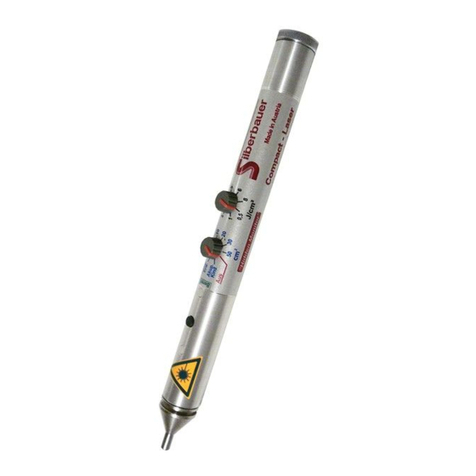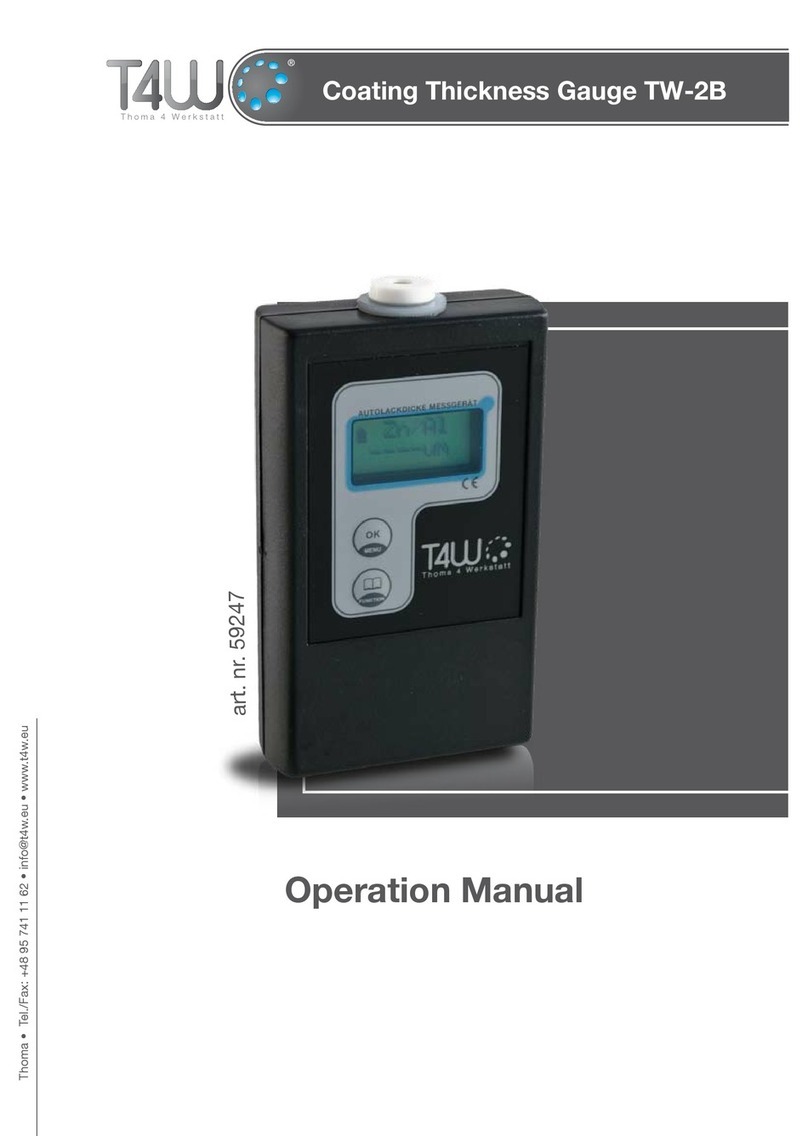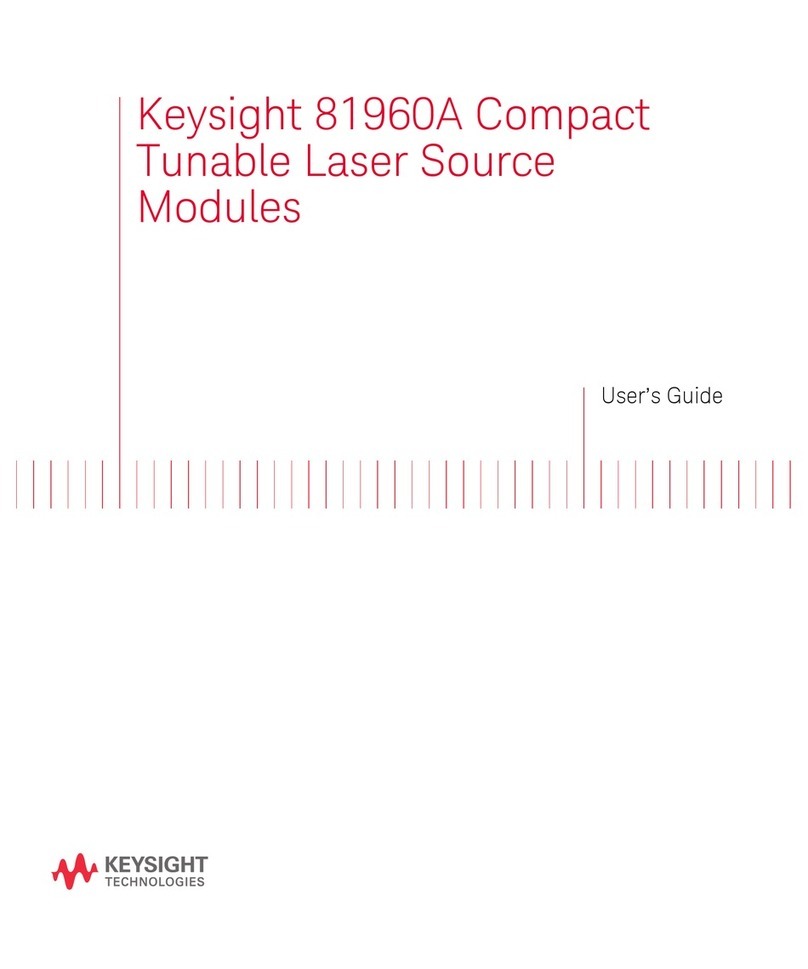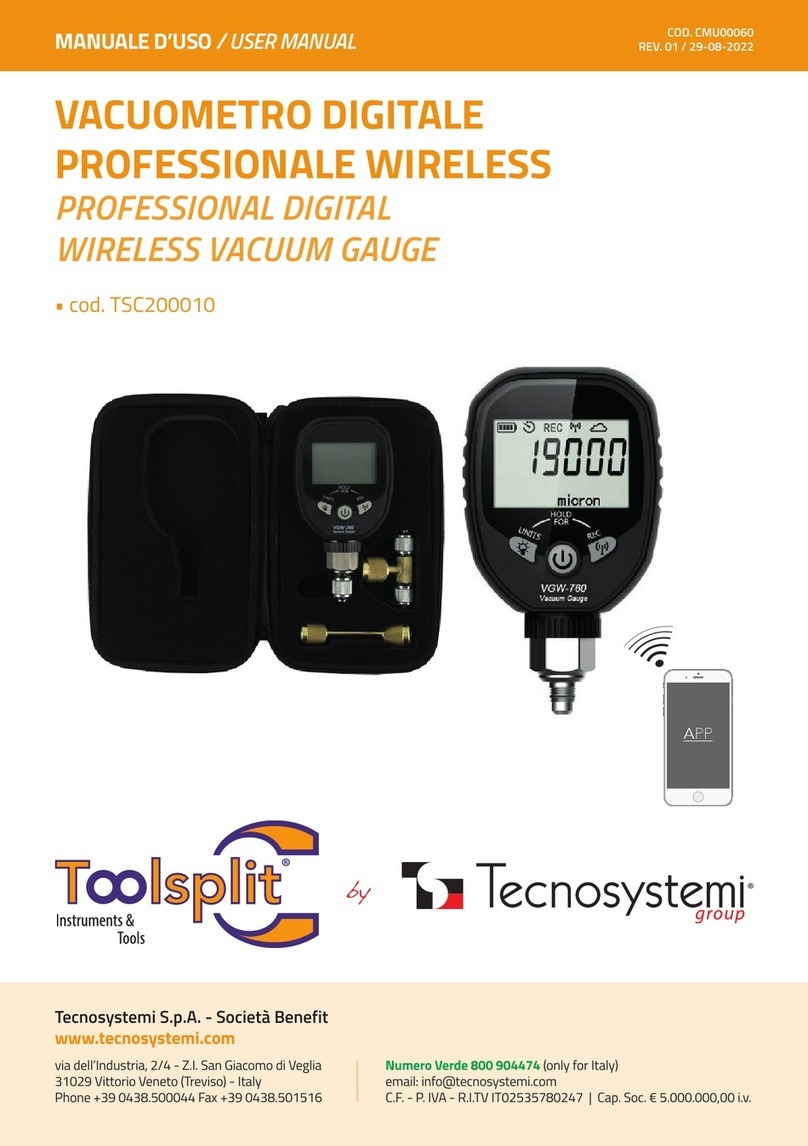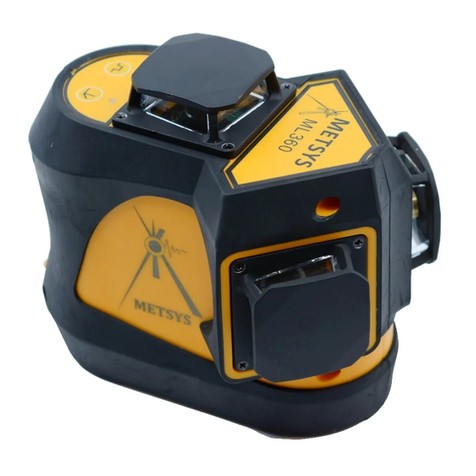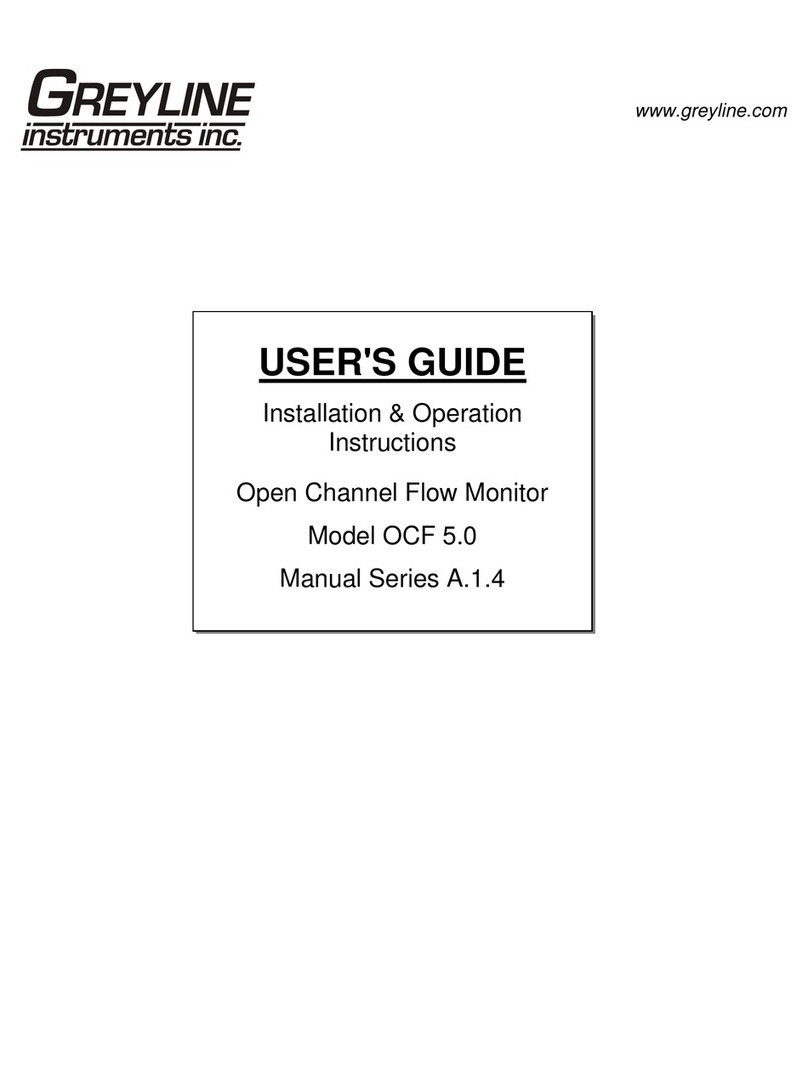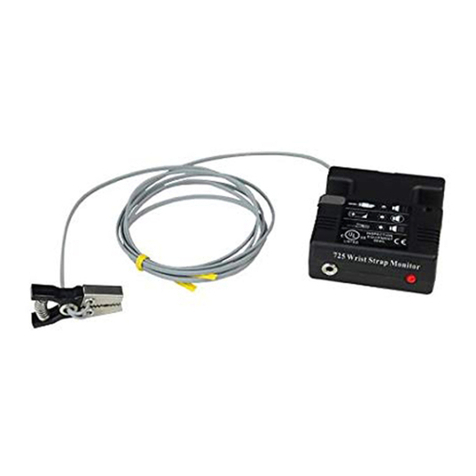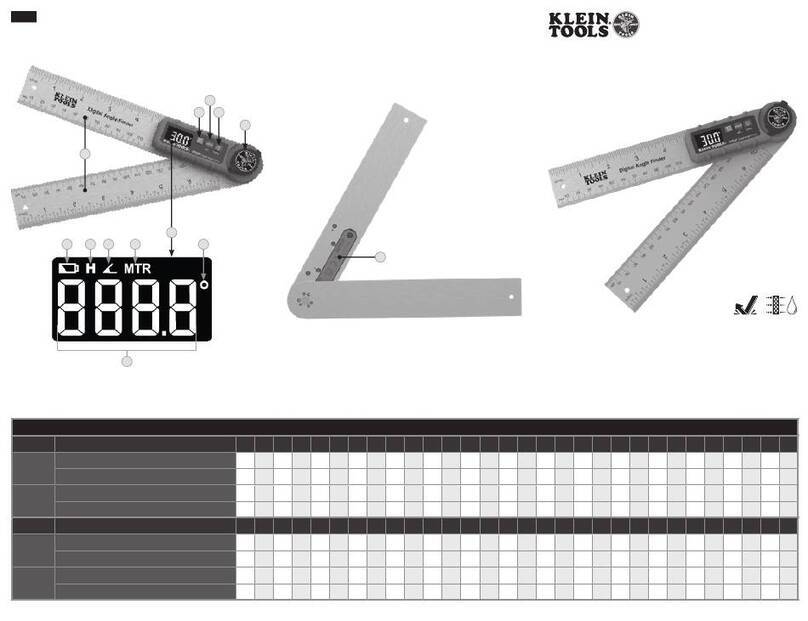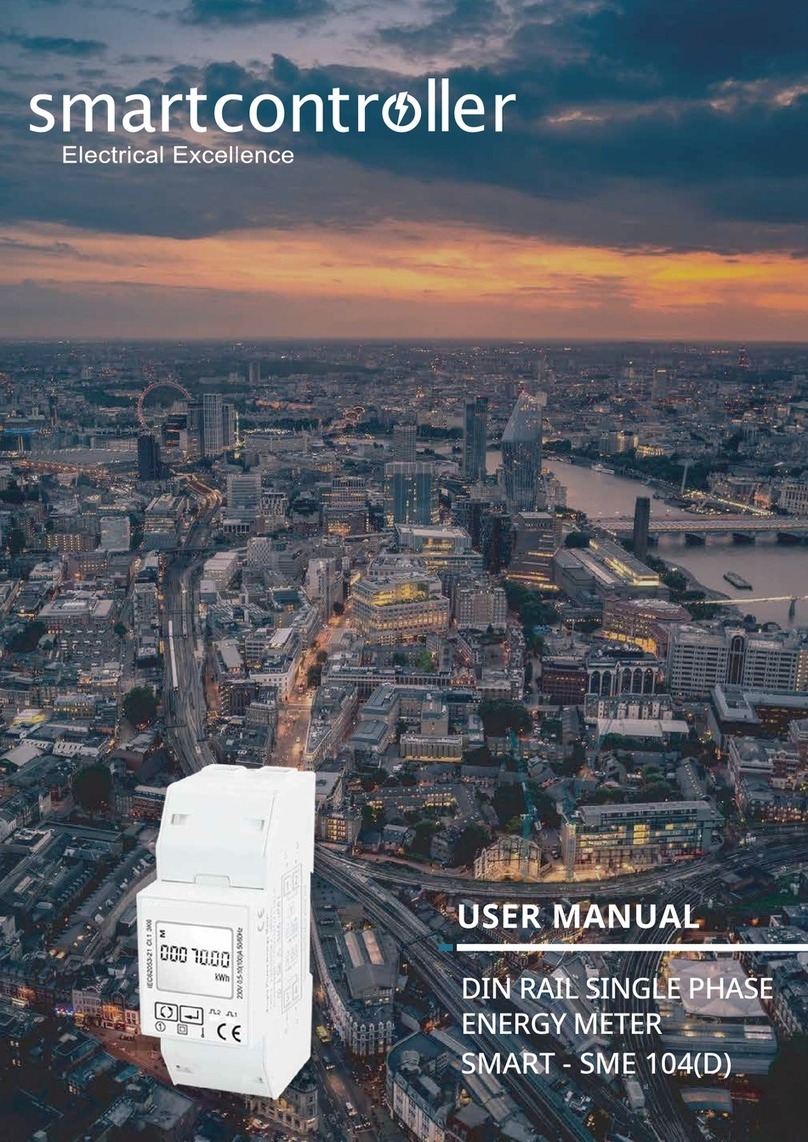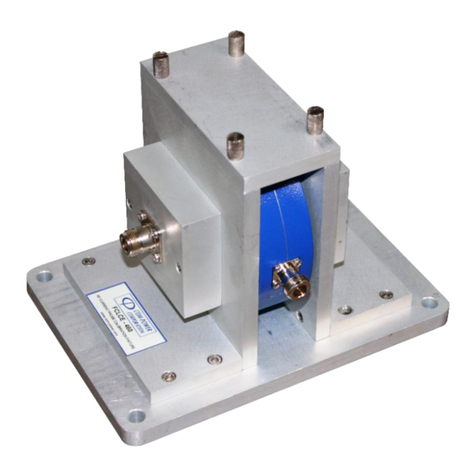Silberbauer Compact-Laser CL mini User manual

Compact - Laser
CL mini
Instructions for use
Type: CL mini xx -658
0044
In Australia and New Zealand:
ACUPAK Pty Ltd,
9 Lawson St.,
East Hawthorn, VIC 3123
Tel: 03 98225454, Fax: 03 98225887
http://acupak.com.au


Content:
page:
0
Permitted Accessories: ........................................................................................ 0
Permitted Protection Goggles: ................................................................... 0
Permitted Device in connection with the CL mini Laser: ............................ 0
1 Description of the Compact Laser CL mini ...................................................... 1
2 Intended Use and Indications .......................................................................... 1
3 Safety precautions to be observed during the use of therapy lasers ................. 2
3.1 Alignment Laser Spectacles (Therapist’s Spectacles): ........................ 3
3.2 Laser Protection Spectacles (Patient’s Spectacles): ............................ 3
3.3 Contraindications ................................................................................ 4
3.4 Requirements for patients ................................................................... 4
3.5 Requirements for user ........................................................................ 5
4 Compact - Laser CL mini : View ....................................................................... 6
4.1 Accessory ............................................................................................ 6
4.2 Initial use .............................................................................................. 6
5 Use of the Compact – Lasers CL mini ............................................................... 7
5.1 Commissioning .................................................................................... 7
5.2 Laser-point and distance of irradiation ................................................. 8
5.3 Irradiation Angle ................................................................................... 9
5.4 Use of the accessories ......................................................................... 9
5.5 Location of Acupuncture points with the Compact – Laser mini: ....... 10
5.5.1. Preparation of the assembly ............................................... 10
5.5.2. Acupuncture point detection on the body ........................... 10
5.5.3. Detection of ear- and skull acupuncture points .................. 11
5.6 Irradiation period and Absorption Doses ............................................ 11
5.6.1 Formule .............................................................................. 11
5.6.2 Measuring units .................................................................. 11
5.6.3 Calculation of the correct dose ........................................... 12
5.7 Control of Use of Lasers ................................................................... 14
5.8 Charge of the NiMH- Battery .............................................................. 14
6 Possible dysfunctions of the laser ................................................................... 15
7 Cleaning, disinfection and maintenance .......................................................... 16
7.1 Laser, Laser Tip and Adapter for Light tube ...................................... 16
7.2 Power Reducing Tip ........................................................................... 16
7.3 Bent Light Tube.................................................................................. 16
8 Waste management of laser and accessory ................................................... 17
9 Warranty .......................................................................................................... 17
10 Laser inspection ............................................................................................ 18
10.1 Scope of inspection:......................................................................... 18
10.2 Inspection Certificate ....................................................................... 19
11 Laser dispatch ............................................................................................... 19
12 Warning advices and Label Information : ...................................................... 20
13 Technical Data: ............................................................................................. 21
EC Declaration of Conformity ............................................................................ 22
Manufacturers Declaration of Conformity (for Australia) .................................... 23
CL_mini_BED11_e.doc Version 11e 2021-02-03

Compact - Laser CL mini Instructions for use
0
Contents:
2 ea. AAA size NiMH – Batteries „Green“
Intelligent Charger for NiMH- Batteries
Luxury Leather Case
lockable Casket, Aluminum
Instructions for use
Applications of the Soft–Laser
Laser goggles “Soft-Caps“
Measurement template for wounds (for mini 30 only)
Instruments book
Laser sign board (Attention Laser Beam)
Permitted Accessories:
Adapter for Light tube
Light tube, bent (Dental top)
Power reducing tip
Laser storage
Permitted Protection Goggles:
Soft-Caps Laser goggles (=glasses for the patient)
Comfort Laser goggles (=glasses for the patient)
Comfort Laser adjust glasses (=glasses for the therapist)
Comfort Laser goggles for children
Permitted Device in connection with the CL mini Laser:
Point Detector PS3, with Safety Connection Cable

Compact - Laser CL mini Instructions for use
1
1 Description of the Compact Laser CL mini
The CL mini is a soft - laser (Low Level Laser) which you can hold in your hand. It is
powered by one standard NiMH battery (size AAA).
The laser light is red and divergent, so that the device complies with the Laser Class
2M.
The light at the slender tip is almost point-like, so you very well may irradiate
punctiform. If you penetrate with a distance of a few centimeters between tip and skin, the
irradiation is circular, wherein the diameter of the circle becomes larger with increasing
distance.
The irradiation time can be adjusted in two stages. In addition, it can also be
selected manually as desired.
2 Intended Use and Indications
The Intended Use of the Compact – Laser CL mini is: radiation of skin, mucous
membrane and dental applications.
It is a “Medical Product“ in accordance with the EU Medical Product Law and with the
Essential Requirements 93/42 EWG and 2007/47 EC.
This unit is approved by TGA.
The main applications are divided into the sections
Accellerating of wound healing and improvement of local defense in the wound
area,especially in older patients, diabetics and impaired wound healing,
Reduction of pain, i.a. after trauma, surgery and chronic degenerative diseases,
for Acupuncture (instead of needling).

Compact - Laser CL mini Instructions for use
2
3 Safety precautions to be observed during the use of
therapy lasers
The appropriate legal security precautions are to be observed!
Open wounds may NOT be touched with the laser or its accessory! Risk of infection!
Upon insertion of the laser tip or of the accessory part "optical fiber bent" in body
openings there is the risk of introducing contaminants into the body – danger of
infection!
When printing with the laser tip on non-intact skin or mucous membrane that could be
pierced – danger of bodily injury and infection!
Laser therapy should be conducted by trained personnel only (= according to the list of trained
persons enrolled in the Instruments Book)!
The use of the operating facilities or installation contingencies in any methods other than
mentioned in these user instructions can lead to dangerous irradiation!
CL mini- Laser must be used and stored within the following temperature range:
Case Temperature: during use 10 to 40 oC (50 to 104 oF),
Storage temp. 0 bis 50 oC (40 to 122 oF)!
Caution is recommended during its transport by car in the summer!
Permissible humidity: 30 till 95 %rel,
The humidity should not condense on the case/body (no dew-drops)!
Air pressure: not critically
No modification of this equipment is allowed!
Portable and mobile HF communication systems may interfere with this instrument!
The use of inflammable anaesthetic gases or oxidized gases like nitrogen (N2O) and oxygen
should be avoided. Some materials like cotton, that are saturated with oxygen, could be set on
fire at these high temperatures, created at the because of the laser’s direction. Before the laser
is put into operation, there should be a specific period for evaporation of solvents in adhesives
and inflammable solvents, which are used for cleaning and disinfection. Attention should be
drawn to the fact that the body’s gases too can set on fire.
It is further recommended that:
Therapy duration for babies being treated at the cranial region should be short (approx. 50%)!
Recommendation to avoid claims for damages by patients who believe that they are now
see worse after irradiation with the laser light:
Avoid direct irradiation of the opened eye!
Do not irradiate the closed eye with a power of over 10 mW!
During radiation to the face use Soft Caps!

Compact - Laser CL mini Instructions for use
3
3.1 Alignment Laser Spectacles (Therapist’s Spectacles):
At the use of lasers of the laser-protection-class 2M
the therapist can wear the laser alignement
spectacles as in accordance with the current
edition of international standard EN208.
Minimal specifications of these spectacles for the
CL mini corresponding to EN208:
Protection level at 658 nm: for CL mini 8: R 1
for all other CL mini lasers: R 2
and admitted for laser mode D (continuous operation)
Silberbauer - laser alignment spectacles offer only protection against accidental
irradiation through laser up to these levels!
They are - according to EN208 - NOT ALLOWED to be used for the deliberate view of
beam!
They are only protection against casual irradiation, when the eye lid closure reflex is
not suppressed or slowed down (medical treatment, illness ...); and thus repeated
irradiations of the eye have to be reduced.
Attention! Colour identification is disturbed by the glasses!
Clean glasses only with a glasses-cleaning-cloth or cloth and windows-detergent.
3.2 Laser Protection Spectacles (Patient’s Spectacles):
The patient should wear laser-goggles. As per the
international standard EN 207 in its current edition.
Minimal Specification of laser protection spectacles
correspond to EN 207:
Protection level at 658nm : L3;
Laser mode: D (continuous operation)
The Silberbauer laser protection spectacles offer only protection against accidental
irradiation through laser up to these powers!
They are - according to EN207 - NOT ALLOWED to be used for the deliberated view
into the beam!
They protect only then against casual irradiation, when the eye lid closure reflex is not
suppressed or slowed down (medical treatment, illness ...); and thus repeated
irradiations of the eye have to be reduced.
Attention! Colour identification is disturbed by the glasses!
Clean glasses only with a glasses-cleaning-cloth or cloth and windows-detergent.

Compact - Laser CL mini Instructions for use
4
3.3 Contraindications
The laser treatment with a Class 2M laser has according to EN60825 no risk. However,
different authors have controversial positions because the laser is especially successful in
applications where you might have concerns for forensic reasons. So some
contraindications should be observed:
Avoid direct irradiation of the open eye!
In the area of open fontanelles or open skullcaps, as well as growth gaps in childhood
and adolescence should not be irradiated.
During pregnancy, the penetration of the abdominal area is to be avoided. Attention!
Sopme acupuncture points can trigger labour (Bl31, Bl32, Bl60, Bl67, Di4, Di5, Gbl21,
Gbl34, LG20, MP6)
Endocrine organs may not be treated!
For epileptics, the scalp region may not be treated.
In case of light dermatoses or higher photosensibility, it is not allowed to penetrate
(for all kinds of dermatoses which react with formation of erythems or vesicles to small
doses of light).
Pacemakers cannot be affected by penetration with the cw- laser, so there are no
contraindications.
Too long therapy time does not
give better results, but also no harmful
side effects. Exceptions are
penetrations in the scalp region (more
minutes), which can cause headache,
and daily penetration with high doses
which can cause that pain comes again.
It is further recommended that:
Therapy duration for babies being
treated at the cranial region should be short (approx. 50%)!
3.4 Requirements for patients
a) Age: Newborn to geriatric patients
b) Weight: >2 kg
c) State of health: not relevant
d) Nationality: all
e) Patient condition: not relevant

Compact - Laser CL mini Instructions for use
5
3.5 Requirements for user
a) Education: at least school leaving certificate, no upper limit
b) Knowledge:
Minimum:
- Reading and understanding of Western Arabic numbers and letters in a language of
the country where the laser is used
- Mathematical knowledge (basic arithmetic, use of a simple formula) to determine the
settings for area and dose per cm²
- Contraindications according to instructions for use
- Basic hygiene knowledge for cleaning and disinfection in the medical sector
- for acupuncture, position of the acupuncture points
- Training on the device (names of the persons registered as trained in the device
book)
no upper limit
c) Experience:
Minimum:
Medical personnel:
- no additional requirements
All other persons:
- Basic knowledge of the human body,
- the names of body parts, joints, organs,
- Names of diseases treated with laser,
- Basic knowledge of wound management
no upper limit
d) permissible impairments:
- slight impairment of reading ability or vision, but Arial 8 must be readable
- 60% reduction of normal hearing ability
- Impairment by hand, but must be able to grip and hold pipes with 20mm diameter
securely

Compact - Laser CL mini Instructions for use
6
4 Compact - Laser CL mini : View
1 2 3 4
Compact - Laser
CL mini xx-658
5 6
7
9
Ser.Nr.:
xxxx H
"Constant Power" 8
1
Laser point 6
Type plate and details
2
Light Emitting Diode, yellow 7
Socket for Silberbauer Point
Detector PS3
3
Push-button 8
Battery Cap
4
Aluminium Body 9
Laser warning label
5
Rotary switch
4.1 Accessory
Adapter and Light tube, bent:
Power loss with optic fibre: 25 % almost!
Direction of the
Laser Beam
Power-reducing-tip:
Direction of the
Laser Beam
Transmission 50%:
e.g.: for CL mini 30 – Output Power reduces to approx. 15 mW
4.2 Initial use
The Silberbauer Compact - Laser mini is delivered with rechargable NiMH- Batteries
in Size AAA and with a charger for these batteries and can be used also with Alkali-Mangan-
Batteries, Type AAA.
Open battery cap (8) at the end of the
laser and insert battery with positive end
pointing into the tube; close the cap and
turn it clockwise until it stops.
Now your Silberbauer Compact - Laser mini is ready to use!

Compact - Laser CL mini Instructions for use
7
5 Use of the Compact – Lasers CL mini
5.1 Commissioning
The rotary switch (5) is for switching the
device on and off and to select the dose time of
penetration.
In “Off“ – position the device is switched off
completely, no waste of battery power.
Nevertheless the battery should be removed from the laser if it is not used for a
longer period because there is the risk of the battery leaking and then the risk of oxidation
of the contacts. This causes a defect of the device!
Before and after each treatment the device should be disinfected, see Chapter 7!
In “Standby“ position the laser is powered up and waits for selection of the
necessary dose (time).
After selection of the dose the laser cannot be started promptly, but only after a
security delay of 2 sec.
Now the laser can be started by pressing the button (3). This button must be hold
down during the whole penetration time because of security. After releasing, the laser will
stop suddenly.
Place the laser perpendicular to the area to be irradiated (see heading "Possibilities for
use of Compact-Laser"),
At the end of every therapy session the rotary switch must turned again into OFF-
position.
The integrated timer starts promptly after pressing the button, the control LED glows
yellow and indicates that the output power has the correct value and that the battery is OK.
The timer stops the laser automatically after the chosen time for therapy and the LED
becomes dark.
Shorter times of irradiation than the shortest selectable time of 15 seconds:
Release the push-button early and the laser stops immediately.
Longer times of irradiation than the longest selectable time of 60 seconds: at the
end of the therapy time, release the laser button (3) and start the therapy by pressing it
again – and the next dose of selected time will start.

Compact - Laser CL mini Instructions for use
8
5.2 Laser-point and distance of irradiation
Direction of the
Laser Beam
The point of the Silberbauer - CL-Laser is created in the shape of a small tube
that follows the cone. The point is easily found through it – the point, where the laser-
radiation radiates on the skin. Normally, nearly inaccessible points, like behind the ear are
easily radiated with no problems.
At the point there is a short light conductor. This light conductor serves among other
things as mechanical protection for the heart of your therapy equipment, the laser diode.
The impact point or the areas of operation are specified by this laser point. With all models
the light emerges, whereby the size of points can be changed according to requirements
through the choice of the distance from the skin.
The irradiation distance can be selected at will! Therefore the laser is allowed
to be set on the skin's surface. The skin can also be pressed in with smooth pressure by
the laser-point, to reduce the distance between deeper-set areas needing to be irradiated
(e.g. area of abdomen).
Apart from this the laser-point is conductive and is connected with the socket at the
rear end of the laser battery. The point-searcher PS3 can be connected to this socket with
a connecting cable. Herewith the laser-point can be used at the same time as searching
point-peak for acupuncture points.

Compact - Laser CL mini Instructions for use
9
5.3 Irradiation Angle
To obtain optimal success during treatment, the laser must be positioned
perpendicular to the skin's surface.
Low reflection, wide reflection,
Optimal penetration depth lower penetration depth
= optimal success = less success
5.4 Use of the accessories
To reduce power, push the power reduction tip onto the laser tip as far as it
will go (see drawing). (Not possible in conjunction with the light conductors!)
When using the bent light tube, first push the adapter onto the laser tip up to the
stop and then push a light tube into the adapter up to the stop; after use, simply pull off
the light guide.
Power-reducing-tip
Direction to put on
Direction of the
Laser Beam
Direction of the
Laser Beam
Light Conductor,
bent
Direction of the
Laser Beam

Compact - Laser CL mini Instructions for use
10
5.5 Location of Acupuncture points with the Compact – Laser mini:
5.5.1. Preparation of the assembly
As well as the Silberbauer Compact - Laser mini (without power reducing tip!) a
Silberbauer Point Detector PS3 and a connection cable is required.
Put one plug of the connecting cable into the rear socket of the laser. The other cable
plug is required to be inserted into the golden socket of the Silberbauer PS3 instead of the
point-search-tip.
The point finder Silberbauer Punktsucher PS 3 must now be handed over into the
hand of the patient. The laser-tip can now serve now as a point finder.
5.5.2. Acupuncture point detection on the body
The Silberbauer Point Detector PS 3 indicates the electrical conductivity of the skin
both optically (with higher or lower frequency of the installed light-diode) and acoustically
(with a varying tone pitch). The latter can be heard by the doctor while focussing his eyes
on the acupuncture point.
Hence the laser tip is positioned slightly diagonally above the acupuncture point,
which should be localized on the skin’s surface. The area assumed to be an acupuncture
point is sought out; then search the area, where you suppose the acupuncture point is,
without lifting the tip from the skin. The pressure of the tip should be light and consistent
while searching.
Continue the search in the direction of a higher tone or a quicker signal. The tone
pitch reaches its maximum light and maximum pitch or frequency at the centre of the
acupuncture point.
The push-button must be pressed on the laser above the acupuncture point thus
beginning the irradiation. The time of therapy programmed in the Silberbauer Compact-
Laser mini is optimised for this kind of application required in every model.

Compact - Laser CL mini Instructions for use
11
5.5.3. Detection of ear- and skull acupuncture points
The acupuncture points at the
cranial zone because of Yamamoto
and at the ear are “silent“ -in contrast
to acupuncture points for the rest of
the body. This indicates that the
electrical conductivity of the skin is
very low there. However if a
disturbance in the organism is
projected to the reflexion zones, the
electric conductivity of the skin
changes at the relevant acupuncture
points and zones. These points can be
located like with the body’s
acupuncture. Very high tones appear
at points with strong disturbances
which should be irradiated.
5.6 Irradiation period and Absorption Doses
Suggested references: e.g.:
Baxter: Therapeutic Lasers – Theory and Practice
Füchtenbusch/Bringmann: Laser Therapy and Laser Acupuncture, Treatment tables
Tunér/Hode: Laser Therapy – Clinical Practice and Scientific Background
Tunér/Hode: The Laser Therapy Handbook
5.6.1 Formule
Energy = Laser power x irradiation period
Irradiation dose = Energy /unit area
5.6.2 Measuring units
Energy: in Joules (J) = Watt-seconds (Ws)
Power: in milli-watt (mW) 1 mW = 0,001 W
Time: in seconds (s)
Unit area: in cm²
Irradiation doses: in J / cm²

Compact - Laser CL mini Instructions for use
12
5.6.3 Calculation of the correct dose
Recommended dose for different applications
Geriatrics
Pain therapy
new scars old scars
Gynecology, Surgery
Dermatology Sports, Physiotherapy
Children, depending of age
Dose (J/cm
2
): u0,5 1 2 3 4 5 6 8
Necessary irradiation period in seconds/cm²
to get a certain dose (left row)
for different laser models (upper line):
CL mini
8
20
30
Dose 0,1
12
5
3
in Joule / cm² 0,2
25
10
7
0,3
42
15
10
Region
0,5
62
25
17
for
0,8
100
40
27
skin:
1
125
50
33
1,5
188
75
50
2
250
100
67
3
375
150
100
in case of pain:
4
500
200
133
5
625
250
167
6
750
300
200
7
875
350
233
8
1000
400
267
9
1125
450
300
10
1250
500
333
12
1500
600
400
This table shows how more power saves time!
Example:
The area to be irradiated is 50 x 10 mm large and should be irradiated with a 8 mW-laser
with 1 Joule per cm².
It is observed from the table that:
1 Joule /cm² = 125 seconds /cm² with the 8 mW-laser,
For 50 x 10 mm = 5 cm² would it be 5 x 125 = 625 seconds for time for, that are more than 10
minutes!

Compact - Laser CL mini Instructions for use
13
Or:
for treatment of areas with help of the card (for mini 30 only!):
Place the card close to the wound and check which circle has the same area like the
wound (e.g. 4x1,8J).
At this circle you find the number how often this dose has to be applied at once (e.g.
4x) and the dose setting of your laser (e.g. 1,8J).
Set your laser to this dose setting. Place the laser tip close to the rim of the wound,
press the start button and remain pressing until the laser switches off.
Now release the button and press it again. Repeat this corresponding to the number.
Example for model CL mini 30 – 658:
In the literature there are values between 0,54 and 3 J/cm2 recommended.
Preset duration time in Joule at Silberbauer CL mini models:
model: at 15 seconds: at 1 minute:
CL mini 8 - 658 0,12 J 0,5 J
CL mini 20 - 658 0,3 J 1,2 J
CL mini 30 - 658 0,45 J 1,8 J

Compact - Laser CL mini Instructions for use
14
For comparison between different Silberbauer laser models:
For penetration of this small wound (1cm2) with 1 J/cm2 (usual
dose) you will need following times:
Model: Seconds:
CL mini 8 - 658 125
CL mini 20 - 658 50
CL mini 30 - 658 33
5.7 Control of Use of Lasers
The Silberbauer Compact - Laser mini has a mechanism for control of the
laser output power:
The yellow light emittimg diode (2) glows when the laser works with 90% of its
rated power at least.
5.8 Charge of the NiMH- Battery
See manual of the battery charger!
Attention! Don’t try to charge normal one use batteries!

Compact - Laser CL mini Instructions for use
15
6 Possible dysfunctions of the laser
Attention must be paid to the existing danger involved in meddling with a
damaged instrument and being exposed to dangerous laser-radiations!
If the yellow lighting LED does not glow once the start-button is pressed,
then please leave the button and observe whether
A few seconds have passed after the rotary switch was switched on?
(It takes about 2 seconds till the laser can be switched on)
Could the battery be flat?
It is enough to recharge the flat battery for a few minutes and irradiation can begin
for a short time!
If the laser does not work in spite of a correct battery or fully charged
battery, please do not make any further attempts, but send or bring the laser together
with the battery for monitoring purposes to our service!
Do not under any circumstance turn or pull the mains adapter or the battery out of
the laser while it is switched on! In case of the tiniest loss of contact – possible after a
dropped battery or laser – the laser-diode could be badly damaged!
Any changes in the device is NOT allowed!
Fluid traces or small colorless or white crystals at the battery or at contacts indicate that a
battery or a rechargeable battery has leaked and the contacts do not work. In this case,
please send the device to the service for professional cleaning!

Compact - Laser CL mini Instructions for use
16
7 Cleaning, disinfection and maintenance
To avoid any danger of infection, the laser point must be disinfected before
and after each treatment (and the power-reducing-tip and the bent light
conductor).
7.1 Laser, Laser Tip and Adapter for Light tube
The laser itself is NOT waterproof and should therefore not be placed in a bath! He
must first be carefully pre-cleaned with a woven cloth moistened with a little tap water to
remove any dirt. It is important to ensure that no water gets into the openings.
Then it can be wiped carefully with a certified practice non-alcoholic disinfectant 1 (its leaflet
must be observed).
The laser head itself and also the adapter for light tubes can also be cleaned and
sanitized in this way.
7.2 Power Reducing Tip
The power reducing tip must be deducted from the laser prior to cleaning. Its hole may
for example be pre-cleaned using toothpicks, tap water and a cloth. Then it must be placed
in a disinfectant (bleach as above) (its leaflet must be observed!).
7.3 Bent Light Tube
Also the bent light tube must be deducted from the laser prior to cleaning.
Now it can be pre-cleaned with tap water and a cloth. Then it can be placed into a
non-alcoholic disinfectant (bleach as above) (observe leaflet of disinfection liquid before
use!).
Direction to put on
Direction of the
Laser Beam
Light conductor, bent
The light tube can also be cleaned chemo-technically with a desinfectant
suitable for acrylic glass (80 °C max.!).
There is no additional maintainance necessary by the user.
1 E.g. Mikrobacforte or Microbac Tissues from BODE; it must be suitable for acrylic glass!
This manual suits for next models
3
Table of contents
Other Silberbauer Measuring Instrument manuals
Popular Measuring Instrument manuals by other brands
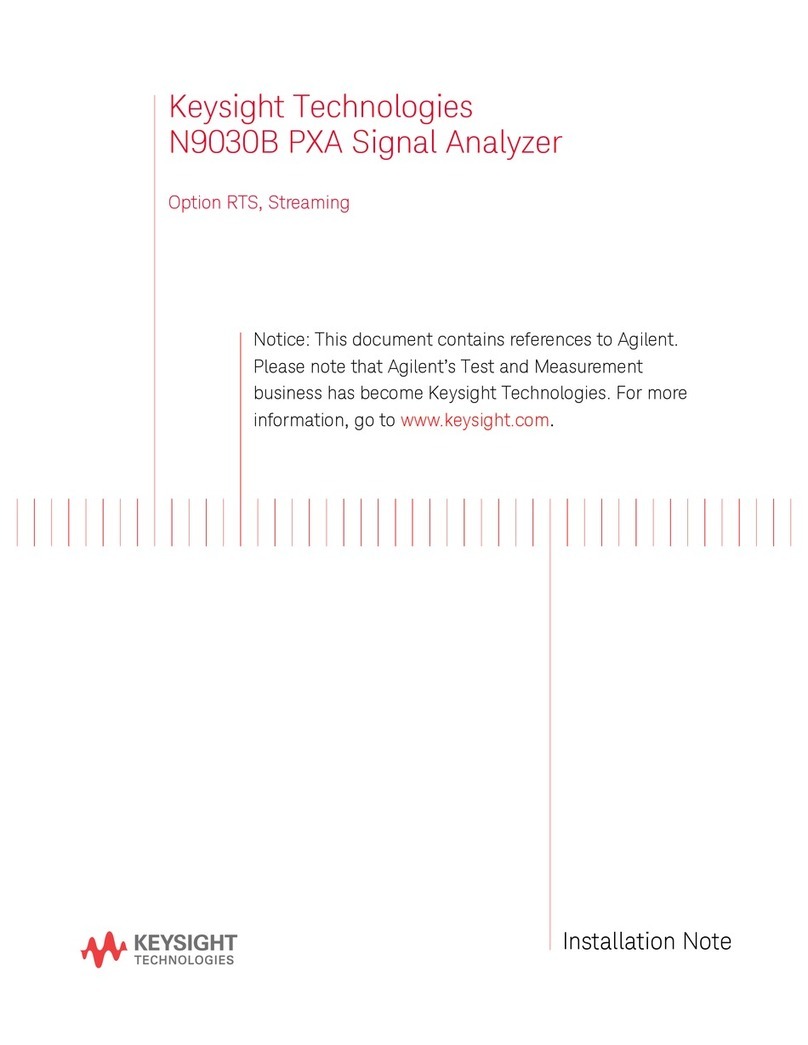
Keysight Technologies
Keysight Technologies N9030B Installation note
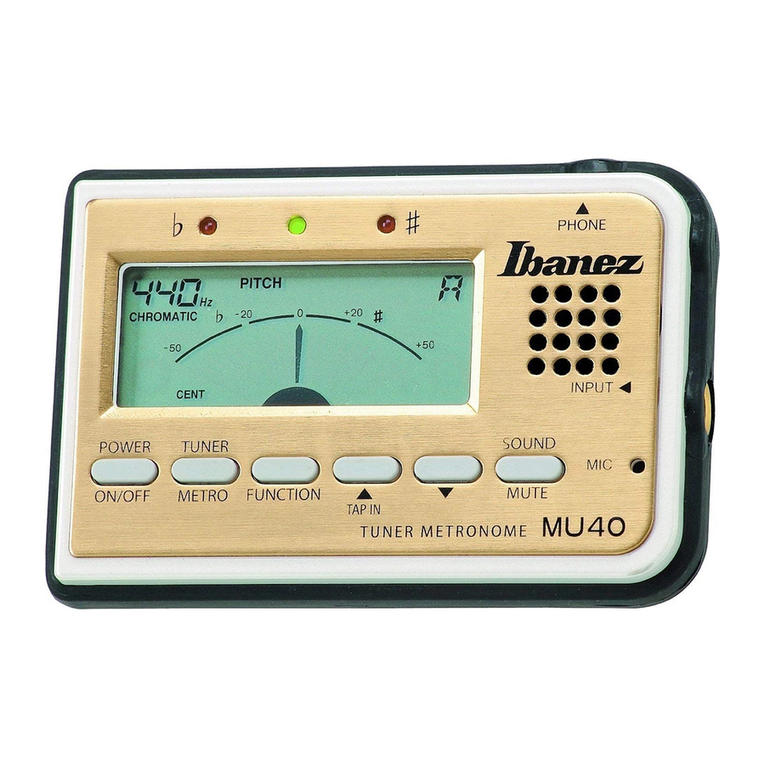
Ibanez
Ibanez MU40 user manual
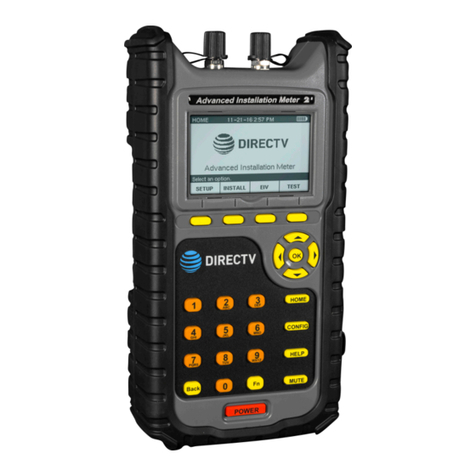
DirecTV
DirecTV Advanced Installation Meter 2 Operation manual
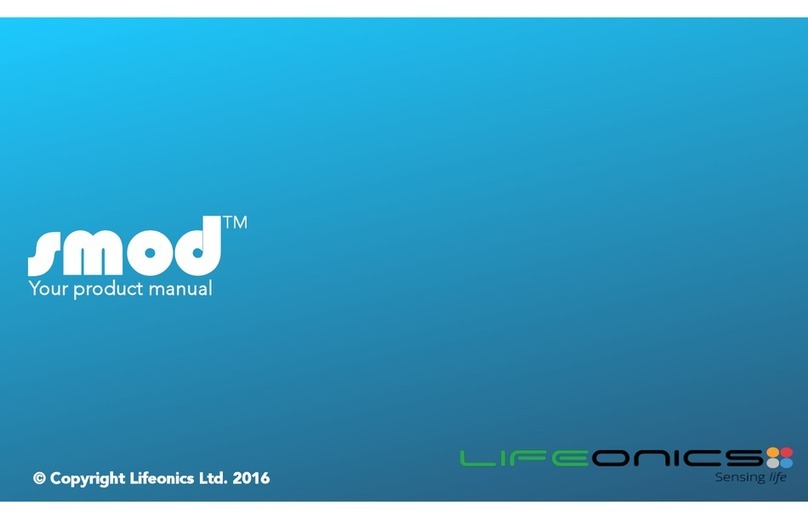
Lifeonics
Lifeonics SMOD product manual

Centrodyne
Centrodyne S700 Installation, operation, & programming manual
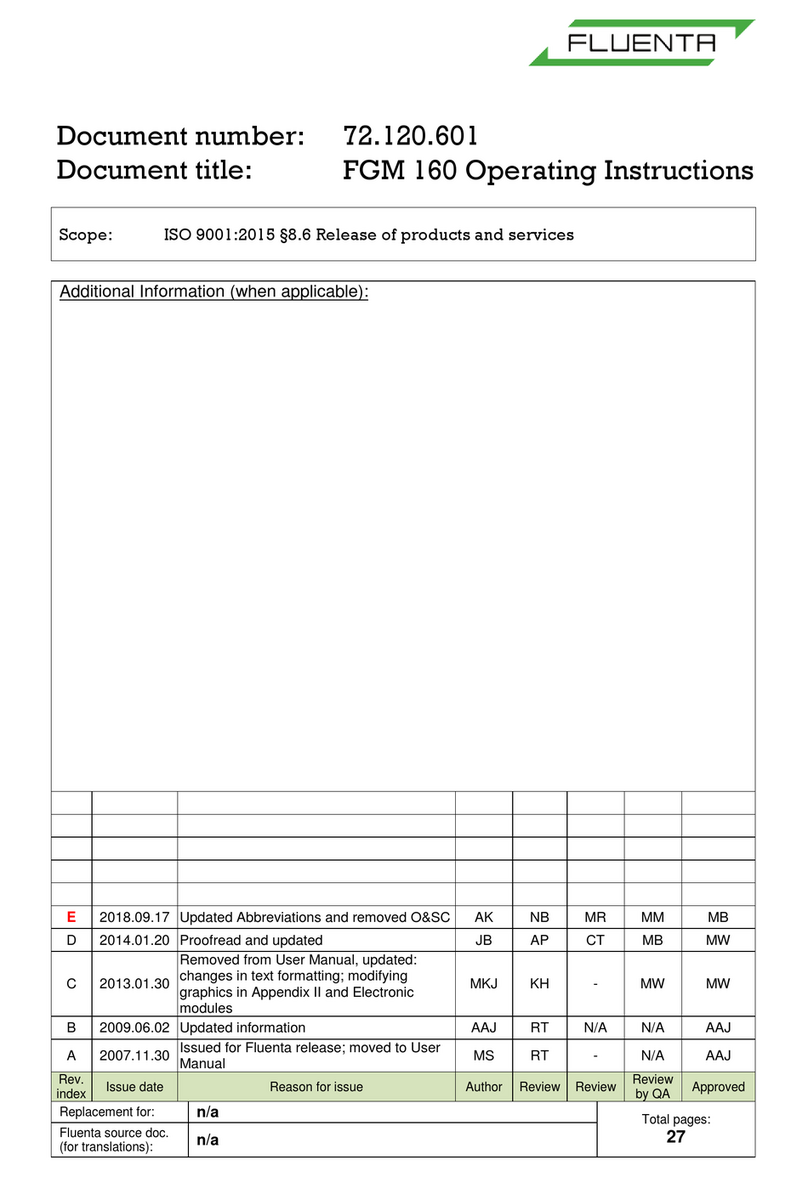
fluenta
fluenta FGM 160 operating instructions
